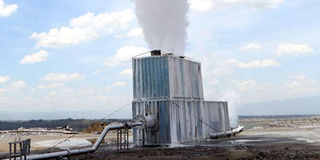Natural gas critical to Kenya’s need

Power generation at Geothermal Development Company plant in Menengai, Nakuru County. Today, more than two-thirds of Kenya’s electricity supply is from geothermal and hydropower sources. FILE PHOTO | NATION MEDIA GROUP
What you need to know:
- Natural gas is fast becoming the clean fuel that will make up a large portion of the global energy mix.
- LNG distribution has suffered from inertia because of a lack of the right infrastructure and the high cost of developing it.
At a recent environmental forum in Nairobi, the Kenya Government reaffirmed its intention to address climate change and reduce greenhouse gas emissions by using cleaner fuels and tapping into renewable energy sources.
Today, more than two-thirds of Kenya’s electricity supply is from geothermal and hydropower sources, with plans to add natural gas to the mix.
However, due to lack of domestic gas supply, Kenya will need to import liquefied natural gas (LNG).
LNG is a ‘natural’ fit for the energy ecosystem in Kenya.
CLEAN ENERGY
AG&P’s infrastructure enables the fuel to become accessible faster and more cost efficiently than before.
Offering a fully integrated solution, from LNG sourcing to last-mile delivery, the firm makes it commercially compelling for customers to switch to natural gas.
Natural gas is fast becoming the clean fuel that will make up a large portion of the global energy mix, due to its optimum performance and lower environmental impact than heavier fuels such as diesel and oil.
Gas and LNG can be sourced from almost anywhere at very competitive prices.
So why hasn’t it taken off on a larger scale in markets such as Kenya?
Despite the growing demand, LNG distribution has suffered from inertia because of a lack of the right infrastructure and the high cost of developing it.
INFRASTRUCTURE
This presents both an opportunity and a challenge.
Kenya can improve the cost-effectiveness of its power generation and the competitiveness of local industries by swapping oil and distillates with LNG and gas as the primary fuel source for power and feed stock.
But, to achieve this, the country needs to ramp up its efforts to establish a well-functioning LNG supply-chain for gas transmission, distribution and storage.
Although the capital expenditure required is substantial, the transition could become a reality sooner with a more innovative approach to infrastructure design and stronger collaboration between the public and private sectors to develop projects.
BENEFITS
AG&P offers an innovative approach to solving LNG distribution challenges.
Its in-house capability eliminates the need for costly and time-consuming third-party engineering and accelerates the construction of assets.
Kenyan project owners can choose the infrastructure configuration they need.
The benefits are threefold – lower capital cost is required; the infrastructure is right-sized to match demand eliminating unwanted surplus; and speed of development means a project is up and running sooner delivering faster returns to investors.
This will enhance affordability, reliability and access.
EMISSIONS
AG&P, with its joint venture partner ALE, designed, developed and co-owns the Hydro Deck, the world’s first giant floating port that was deployed to the Ichthys LNG Project in Darwin, Australia, the world’s largest gas infrastructure project.
The Hydro Deck enabled the Darwin Port, with its eight-metre tidal variations, to be operational 24/7.
AG&P also designed and built the electrical houses – the electrical nerve centre – for the same project.
LNG’s status as the cleanest fossil fuel cannot be understated.
It results in 45 per cent less carbon dioxide emissions than coal, and 30 per cent less than fuel oil.
RENEWABLE ENERGY
The amount of nitrogen oxide as well as damaging sulphur dioxide is also drastically reduced.
LNG is, therefore, a critical component of any country’s environmental policy, where economic development and the reduction of greenhouse gases are high on the agenda.
Let’s not forget that wood fuel and other biomass still account for 68 per cent of the total energy consumption in this country of 50 million people.
What’s more, LNG is complementary to Kenya’s current use of renewable energy.
Base load power is fundamental to the success of any economy.
ECONOMY
LNG is the ideal complement to renewables, filling gaps during off peak times, enhancing grid stability.
With a forecast economic growth of six per cent next year, increased power and a stable base-load will certainly enable the success of Kenya’s main growth sectors, including industry and agriculture, as well as the development of transport and infrastructure.
Adding LNG to Kenya’s national grid will result in communities and industries gaining access to clean and cheaper fuel that will spur GDP growth and significantly improve lives.
Mr Nico van Niekerk is the vice-president, Business Development Africa, AG&P (Atlantic, Gulf and Pacific Company). [email protected]




